Directions
The refuge headquarters is located on Lousisiana Highway 1194, 3.9 miles from the junction of Highway 1194 and Highway 1 in Fifth Ward, Louisiana. Highway 1194 becomes Island Road 0.5 mile from the headquarters. An alternate route to the refuge from Marksville, Louisiana is south on Highway 115 to Little California Road, 3.3 miles to Island Road, the headquarters is 0.5 mile left from the intersection of Little California Road and Island Road.
Phone
318-253-4238
Activities
BOATING, INTERPRETIVE PROGRAMS, FISHING, HIKING, WILDLIFE VIEWING
Camping Reservations
Reserve your campsite at these camping areas:
Hiking Trails
Looking for nice hiking areas to take a hike? Choose from these scenic hiking trails:
Related Link(s)
More Louisiana Recreation Areas
Grand Cote National Wildlife Refuge
Grand Cote National Wildlife Refuge was established in 1989 to provide valuable waterfowl habitat in the Mississippi/Red River floodplain as part of the North American Waterfowl Management Plan. The 6,000 acre refuge is located in Avoyelles Parish outside of Marksville, Louisiana. Prior to clearing, this productive bottomland hardwood ecosystem provided ideal habitat for forest wildlife, but the shift toward agriculture and shallow marsh has made it more attractive to a wide variety of waterfowl, wading birds, and shorebirds. Due to its location in east-central Louisiana, the refuge is influenced by both the Mississippi and Central Flyways and the large expanses of shallow wetlands draw a diversity of waterfowl species. Although Northern pintails, mallards, wood ducks, and green-winged teal are the dominant species, blue-winged teal, northern shovelers, gadwall and American wigeon are also common during the fall and winter months. Large numbers of snow and white-fronted geese winter on the refuge. During the spring and summer months, a variety of migratory songbirds utilize the bayous, scattered forested tracts, and shallow marsh habitat. Numerous native species of mammals, reptiles, amphibians, fishes and insects are common residents of the refuge. The Louisiana black bear and bald eagle are both threatened species that could potentially be observed on the refuge.






